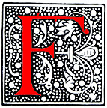Want to know how to navigate the Victorian Web? Click here.
 ollowing the German art fairy tale or Märchen, George Macdonald employs a dream or dreamlike structure, revealing that to him the world of the spirit must be seen in terms of human psychology, the human inner world. In fact, a great many Victorian and later fantasies employ such dream structure, for the movement into the subjective world of the mind is the first step into fantasy. Essentially, there are two ways to claim that the world of everyday reality, the world of the realistic novel, is inadequate to human needs: the first is to claim that a higher world of religious or political ideas and ideals is more important, more relevant; while the second is to claim that the inner worlds of the human mind, its subjective experiences, have primary value. Lewis and Macdonald embody the first view; Kafka and Lovecraft the second.
ollowing the German art fairy tale or Märchen, George Macdonald employs a dream or dreamlike structure, revealing that to him the world of the spirit must be seen in terms of human psychology, the human inner world. In fact, a great many Victorian and later fantasies employ such dream structure, for the movement into the subjective world of the mind is the first step into fantasy. Essentially, there are two ways to claim that the world of everyday reality, the world of the realistic novel, is inadequate to human needs: the first is to claim that a higher world of religious or political ideas and ideals is more important, more relevant; while the second is to claim that the inner worlds of the human mind, its subjective experiences, have primary value. Lewis and Macdonald embody the first view; Kafka and Lovecraft the second.
Novel and fantasy touch upon each other in this matter of the inner world, and if one envisages a spectrum of fictions with the realistic novels of Eliot and Trollope at one end and the fantasies of Macdonald and Lindsay at the other, the novel of psychological realism occupies a middle position and shares qualities of both. Thus, Jane Eyre, which purports to convey both the objective experiences and inner world of its orphan protagonist, has as much in common with the creations of Macdonald as it does with those of Thackeray, Trollope, and Gaskell. Modernist and later fiction which employs stream-of-consciousness narration and episodic, discontinuous structure often seems far closer to Phantastes than to Middlemarch or The Way We Live Now.
References
From George P. Landow, "And the World Became Strange: Realms of Literary Fantasy", The Georgia Review Volume 33, Number 1 (Spring 1979): 28.
Last modified 12 October 2002